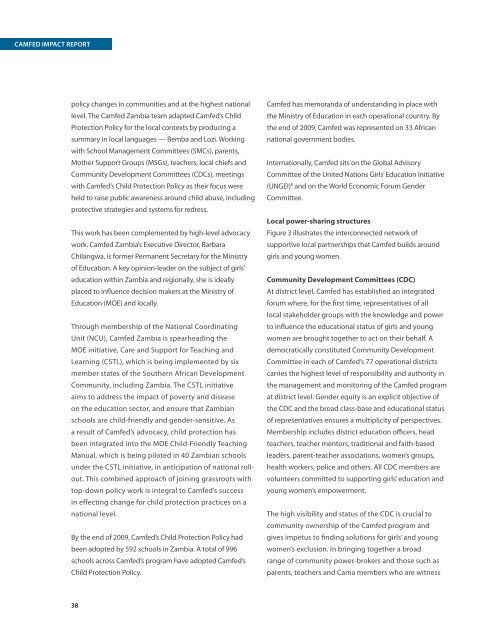Download 2010 Camfed Impact Report PDF - United Nations Girls ...
Download 2010 Camfed Impact Report PDF - United Nations Girls ...
Download 2010 Camfed Impact Report PDF - United Nations Girls ...
You also want an ePaper? Increase the reach of your titles
YUMPU automatically turns print PDFs into web optimized ePapers that Google loves.
CAMFED IMPACT REPORT<br />
policy changes in communities and at the highest national<br />
level. The <strong>Camfed</strong> Zambia team adapted <strong>Camfed</strong>’s Child<br />
Protection Policy for the local contexts by producing a<br />
summary in local languages — Bemba and Lozi. Working<br />
with School Management Committees (SMCs), parents,<br />
Mother Support Groups (MSGs), teachers, local chiefs and<br />
Community Development Committees (CDCs), meetings<br />
with <strong>Camfed</strong>’s Child Protection Policy as their focus were<br />
held to raise public awareness around child abuse, including<br />
protective strategies and systems for redress.<br />
This work has been complemented by high-level advocacy<br />
work. <strong>Camfed</strong> Zambia’s Executive Director, Barbara<br />
Chilangwa, is former Permanent Secretary for the Ministry<br />
of Education. A key opinion-leader on the subject of girls’<br />
education within Zambia and regionally, she is ideally<br />
placed to influence decision makers at the Ministry of<br />
Education (MOE) and locally.<br />
Through membership of the National Coordinating<br />
Unit (NCU), <strong>Camfed</strong> Zambia is spearheading the<br />
MOE initiative, Care and Support for Teaching and<br />
Learning (CSTL), which is being implemented by six<br />
member states of the Southern African Development<br />
Community, including Zambia. The CSTL initiative<br />
aims to address the impact of poverty and disease<br />
on the education sector, and ensure that Zambian<br />
schools are child-friendly and gender-sensitive. As<br />
a result of <strong>Camfed</strong>’s advocacy, child protection has<br />
been integrated into the MOE Child-Friendly Teaching<br />
Manual, which is being piloted in 40 Zambian schools<br />
under the CSTL initiative, in anticipation of national rollout.<br />
This combined approach of joining grassroots with<br />
top-down policy work is integral to <strong>Camfed</strong>’s success<br />
in effecting change for child protection practices on a<br />
national level.<br />
By the end of 2009, <strong>Camfed</strong>’s Child Protection Policy had<br />
been adopted by 592 schools in Zambia. A total of 996<br />
schools across <strong>Camfed</strong>’s program have adopted <strong>Camfed</strong>’s<br />
Child Protection Policy.<br />
<strong>Camfed</strong> has memoranda of understanding in place with<br />
the Ministry of Education in each operational country. By<br />
the end of 2009, <strong>Camfed</strong> was represented on 33 African<br />
national government bodies.<br />
Internationally, <strong>Camfed</strong> sits on the Global Advisory<br />
Committee of the <strong>United</strong> <strong>Nations</strong> <strong>Girls</strong>’ Education Initiative<br />
(UNGEI) 8 and on the World Economic Forum Gender<br />
Committee.<br />
Local power-sharing structures<br />
Figure 3 illustrates the interconnected network of<br />
supportive local partnerships that <strong>Camfed</strong> builds around<br />
girls and young women.<br />
Community Development Committees (CDC)<br />
At district level, <strong>Camfed</strong> has established an integrated<br />
forum where, for the first time, representatives of all<br />
local stakeholder groups with the knowledge and power<br />
to influence the educational status of girls and young<br />
women are brought together to act on their behalf. A<br />
democratically constituted Community Development<br />
Committee in each of <strong>Camfed</strong>’s 77 operational districts<br />
carries the highest level of responsibility and authority in<br />
the management and monitoring of the <strong>Camfed</strong> program<br />
at district level. Gender equity is an explicit objective of<br />
the CDC and the broad class-base and educational status<br />
of representatives ensures a multiplicity of perspectives.<br />
Membership includes district education officers, head<br />
teachers, teacher mentors, traditional and faith-based<br />
leaders, parent-teacher associations, women’s groups,<br />
health workers, police and others. All CDC members are<br />
volunteers committed to supporting girls’ education and<br />
young women’s empowerment.<br />
The high visibility and status of the CDC is crucial to<br />
community ownership of the <strong>Camfed</strong> program and<br />
gives impetus to finding solutions for girls’ and young<br />
women’s exclusion. In bringing together a broad<br />
range of community power-brokers and those such as<br />
parents, teachers and Cama members who are witness<br />
38
















